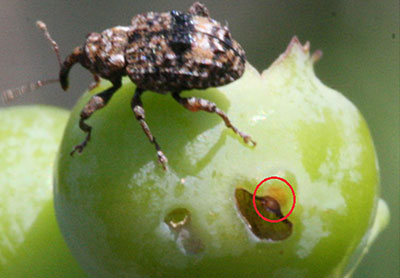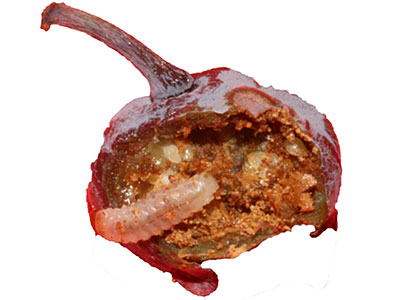Fact Sheet FS1229
Plum curculio (Figure 1), native to North America, is one of the most important insect pests of commercially cultivated blueberries in New Jersey. There is zero tolerance for plum curculio infestation in marketable fruit, since the presence of larvae, as well as feeding and oviposition scars, result in fruit rejection by consumers.

Figure 1. Plum curculio adult on developing blueberry fruit. Also visible is crescent shaped oviposition scar with egg site within the red circle. Photo credit: Dean Polk.
Appearance
Adults are about 1/4 inch long, small grayish brown weevils with long snouts about 1/4 to 1/3 the length of the body. There are mottled gray markings on the back, and two humps on the backs of the wing covers. Larvae are curved, yellowish-white to cream colored, with a brown head and a lighter brown area just in back of the head. Fully grown larvae are 1/4 to 3/8 inch long, and legless but clearly segmented.
Life History
It was initially believed that plum curculio had one generation per year (univoltine), although recent evidence from some mid-Atlantic states suggests that there may be populations of plum curculio with more than one generation per growing season (multivoltine). Adults overwinter in leaf litter and become active during spring. They move from the overwintering sites in April-May to the host plants where males and females mate. The first spring activity is usually seen as fruit begins to set, and when temperatures reach 50–60°F for at least 3–4 days, or 70–75°F for two days. Females lay eggs on the fruit, and after hatching, light colored larvae develop inside the fruit (one larva per fruit; Figure 2). Mature larvae exit the fruit to pupate in the soil, and emerge as adults in July and August. Newly emerged adults may feed on the fruit again late in the growing season and eventually move to their overwintering sites for hibernation.
Damage
Adults feed on flowers and young developing fruits shortly after petal fall, causing feeding scars. When females oviposit on the fruit they eat out a small crescent-shaped area, and deposit an egg just under a flap of skin on the 'straighter side' of the crescent, resulting in the telltale crescent-shaped egg scar (Figure 1). After eggs hatch the larva burrows into the fruit. Larval feeding causes fruit to develop prematurely and fall off the bush. Contamination with plum curculio larvae is of particular concern in early season blueberry varieties as harvest may take place before the larvae have exited the fruit and dropped to the ground, thereby producing larval-infested fruit.
Monitoring
Monitoring plum curculio adults in blueberry fields is challenging due to cryptic coloration, nocturnal behavior, and tendency to deliberately fall on the ground when they perceive a threat (thanatosis). As an alternative, visual inspection of fruit for the characteristic crescent oviposition scars can be used to monitor plum curculio populations (Figure 1). The use of beating tray sampling can often be used as a reliable sampling method, since adults will readily drop onto the beating cloth when the bush is "jarred." While scouting, more sampling effort should be directed towards field edges and in fields that border woods and hedgerows. Plum curculio infestations are more common in weedy fields and those with sod middles.

Figure 2. A developing plum curculio larva feeding inside blueberry fruit. Photo credit: Dean Polk.
Control
Since there is a zero tolerance for infested fruit, control options should be initiated once adults are found in the spring. In fields that have a history of severe damage, both pre-bloom and post-bloom insecticides can be used. An insect growth regulator, Rimon® (Novaluron – IRAC group 15), can be used before bloom to prevent fruit infestation in fields with previous high plum curculio pressure. Rimon inhibits chitin formation. Chitin is a type of biological polymer that is a principal component of an insect's exoskeleton, and a necessary component for embryonic development. Rimon affects female egg laying behavior and egg and larval development, and suppresses overall fertility. Post-bloom insecticides should be used once bees have been removed from the fields. These include Avaunt® (Indoxycarb – IRAC group 22), Imidan® (Phosmet – IRAC group 1B), or any of three pyrethroids – IRAC group 3: Danitol® (Fenpropathrin), Brigade® (Bifenthrin), and Mustang Max® (Zeta-cypermethrin).
Mention or display of a trademark, proprietary product, or firm in text or figures does not constitute an endorsement by Rutgers Cooperative Extension and does not imply approval to the exclusion of other suitable products or firms.
March 2014
Copyright © 2024 Rutgers, The State University of New Jersey. All rights reserved.
For more information: njaes.rutgers.edu.
Cooperating Agencies: Rutgers, The State University of New Jersey, U.S. Department of Agriculture, and Boards of County Commissioners. Rutgers Cooperative Extension, a unit of the Rutgers New Jersey Agricultural Experiment Station, is an equal opportunity program provider and employer.

